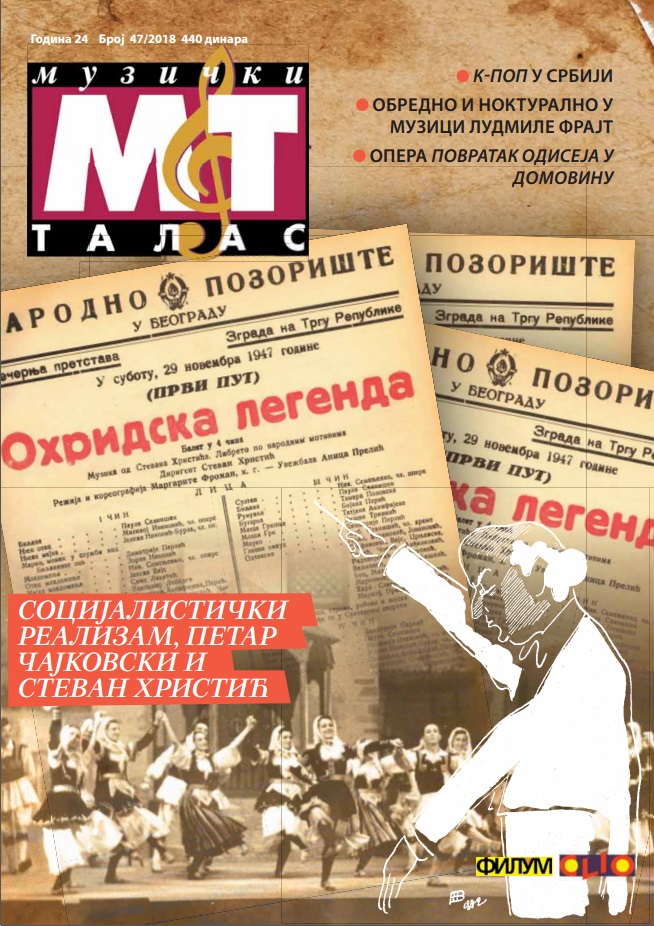Социјалистички реализам, Петар Чајковски и Стеван Христић: спасавање лепотице
Socialist Realism, Pyotr Tschaikovsky and Stevan Hristić: Rescuing the Beauty
On occasion of seveventieth anniversary of Margarita Froma
Author(s): Nadežda MosusovaSubject(s): Cultural history, Music
Published by: Izdavačko preduzeće CLIO
Keywords: The Legend of Ohrid; The Sleeping Beauty; Tschaikovsky; Hristić; socialist realism
Summary/Abstract: Let us remember that the opening night of Hristich’s full-length ballet The Legend of Ochrid in Belgrade 1947 and the renewal of Tchaikovsky’s Sleeping Beauty 1952 after Petipa at Moscow Bol’shoy Theatre took place in time of hardest action of Zhdanovism in URSS and its satelites. At the first sight the folkish Legend and elitistic Beauty have nothing in common. However, their paths, be it existential or artistic were contiguous and crossing. Therefore is interesting to follow the genesis and performing history of two compositions, especially after the end of the Second World War. Why are brought together these two ballets? Idea came from an observer at the International Festival of Music and Drama established in Edinbrurgh after the WW 2. After the gala performance of full-length ballet The Legend of Ochrid by Stevan Hristich at the Festival in 1951 a lot of attention was paid to the Serbian work. One overview was obviously of an aesthetical as well as of a pedagogical character, the latter concerning British production of ballet music. So the anonymous author of the article Yugoslav Ballet in Edinburgh in The Ballet, London, November 1951, Vol. II, No 10, 48 wrote that The Legend is as long as the Sleeping Beauty (was running in Covent Garden from 1946 on) and that there is a high time for British composers to write a full-length ballet. This was done by Benjamin Britten who composed The Prince of Pagodas premiered in 1957. In 1958 The Legend was mounted in Moscow’s Stanislavsky&NemirovichDanchenko Theatre. For Russian ballet authorities, the Hristich’s composition was not long enough, so the composer had to add some more music. First act. In a medieval Balkan village near Lake Ochrid two young people, Biljana and Marko are in love. Suddenly, the Turks are attacking, setting village on fire, killing a lot of male inhabitants. Together with other girls Biljana is taken away as a slave. II. Marko, who escaped the slaughter, started to search his beloved. He reaches banks of the Lake. The water nymph presents Marko with ring, flower and the sword. With these magic objects, led by the Morning Star, he is going to liberate Biljana. III. Slaves are brought to the imperial palace in Constantinopole. They are forced to dance in front of Sultan. Biljana also dances expressing her protest. When she is going to be taken to Sultan’s harem, appears Marko, resisting with the sword attacks of the Turkish guards. In the midst of the fight, he throws ring and flower to Biljana which transform her into a dove. Marko clears his way back and runs away. IV. In the village the survived peasants are trying to rebuild burnt houses. Marko is among them. In a moment in flies a white dove, turning into Biljana. There are now no obstacles for the happy couple to be married. The synopsis of the Legend was left the same, also in the future, regardless of the changes in choreography. But, at the beginning of 1920tieth The Sleeping Beauty‘s scenario had to undergo some socialist retouches, dictated by communist authorities. The court of French king Louis XIV had to be transformed into a Sunny Commune , a street spectacle, representing a place of people of the whole world, celebrating the victorious Revolution heralded by the Red Dawn (Aurora). After some efforts, the engaged author of such an enterprise and his “order-makers” renounced. Tchaikovsky’s music was too lyrical, too noble for such a barbaric treatment. The Petipa’s choreography was saved. The communist bureaucracy in Yugoslavia rejected The Legend of Ochrid for it retrograde content thus saving the Hristich’s ballet from the socrealistic label. Now, the common denominator is construction of both ballets and the music also: The Legend is built after the Russian model (Swan Lake – so Ana Radoshevich, or The Beauty) and musically (also by its content) bears traces of the Russian Orient (Raymonda). British critics made similar comparisons, mentioning also Rimsky-Korsakov’s Sadko (the symphonic poem and opera as well). What have two ballets in common with socialistic realism? The Legend’s survival and unbelievable popularity in communist Yugoslavia, as well as the renaissance and vitality of Sleeping Beauty among Soviets (“Ballet as the mean of propaganda!”) were not at all conditioned by the state doctrine’s postulates of “narodnost”, “idejnost” or “partijnost”. On the contrary, the invincible aesthetical impact of both Russian and Serbian dancing creations kept them alive. Thus the beauty is saving the art and also the whole world.
Journal: Muzički talas
- Issue Year: 24/2018
- Issue No: 47
- Page Range: 2-11
- Page Count: 10
- Language: Serbian
- Content File-PDF

